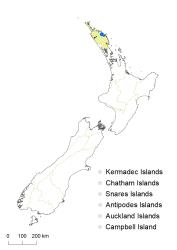- ≡ Aspidium formosanum Christ, Bull. Herb. Boissier sér. 2, 4: 615 (1904)
Dryopteris formosana has an erect rhizome, dark brown to almost black scales on the stipe and rachis, laminae that are pentagonal and 3-pinnate to 3-pinnate-pinnatifid, 1–2 basiscopic secondary pinnae on the basal primary pinnae that are longer than the corresponding acroscopic secondary pinnae, aristate teeth on the ultimate lamina segments, light brown weakly inflated scales on the abaxial costa surfaces, and reniform indusia (Hoshizaki & Moran 2001).
North Island: Northland.
Altitudinal range: c. 15 m.
Collected as a self-sown plant in cultivation in Kerikeri.
Occurs naturally in China, Korea, Japan, Taiwan and Philippines.
Recorded as self-sown c. 5 m away from a cultivated plant.
Ogle et al. (2021). Voucher AK 374687, 2018.






